
With a topic as complex and nuanced as your brand positioning strategy it’s easy to get lost. There are lots of resources to guide your approach and thinking but it still requires taking an abstract idea and applying it to your brand.
This involves some serious mental heavy lifting.
To make this process easier I’m always thinking about ways to use visuals to help simplify and communicate strategy concepts.
There’s something about a good image that can help an otherwise complex idea become clear – and memorable.
The following are 11 core ideas on how to create a strong brand positioning strategy expressed in graphic form.
You can think of these as a set of mini-strategy lessons.
They’re not in any particular order and each one can stand on its own.
And like puzzle pieces – as you lock each one into place, you start to see more of the collective picture it creates. It won’t answer every question about your positioning strategy but it will help you improve alignment with your target customers and establish a unique position in the landscape.
1. The 3 buckets of positioning value
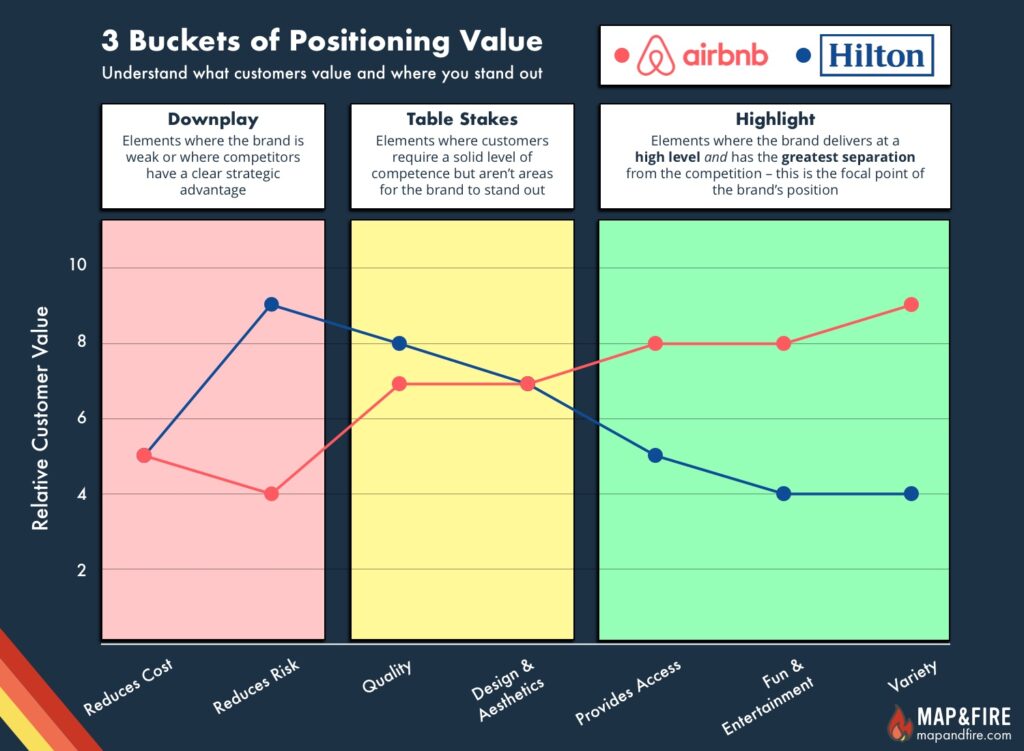
A strong brand positioning strategy does not mean you deliver at the highest level across all points of value.
This is a common misconception that can get you stuck.
It stems from the idea that if we’re great at everything, our customers will love us even more.
In reality we have to make trade-offs.
The most classic version of this is the old saying: “Fast, cheap, good – pick 2”.
But there’s a lot more nuance to this when you dig into all the different types of value that customers consider in a buying decision.
Downplay
Elements where the brand is either weak or where competitors have a clear strategic advantage. The brand should address these to avoid creating potential blockers.
Table Stakes
Elements that need a solid level of competence but aren’t areas for the brand to stand out. The brand shows customers that these are important without it being the primary focus.
Highlight
Elements where the brand delivers at a high level and has the greatest separation from the competition – this is the focal point of the brand’s position and needs to be emphasized across all sales and marketing channels.
2. Competition comes in many different forms

“We don’t really have any competition.”
This is a theme you often hear from folks who believe they’ve created a novel, super innovative solution.
It creates the perfect entry point for Jobs to Be Done thinking.
The most narrow view of competition is to look only at direct competitors. i.e. solutions that meet the same customer needs in roughly the same way.
When people claim they don’t have competition this is what they’re thinking about.
There isn’t another company out there that delivers this type of solution.
It’s looking at the world through a product-first lens.
The problem is that’s not how your customers operate.
Jobs to Be Done gets us thinking about our customers through their eyes – what challenges are they looking to satisfy in their lives?
It’s looking at the world through a customer-first lens.
When you do this it opens up the world to all kinds of possibilities.
Using the example below, if Slack didn’t exist their customers wouldn’t be stuck with only Microsoft Teams or Discord (or some other business chat tool) as their options.
They have all kinds of ways to meet the same JTBD of communicating with their team.
In fact, to this day Slack still has a link to “Slack vs. Email” in the footer of their website. Even with how ubiquitous these solutions have become, email is still probably their biggest competitor. That’s where they stand to gain the most new customers – converting people who still default to email.
3. Why positioning should be on every CFO’s wishlist
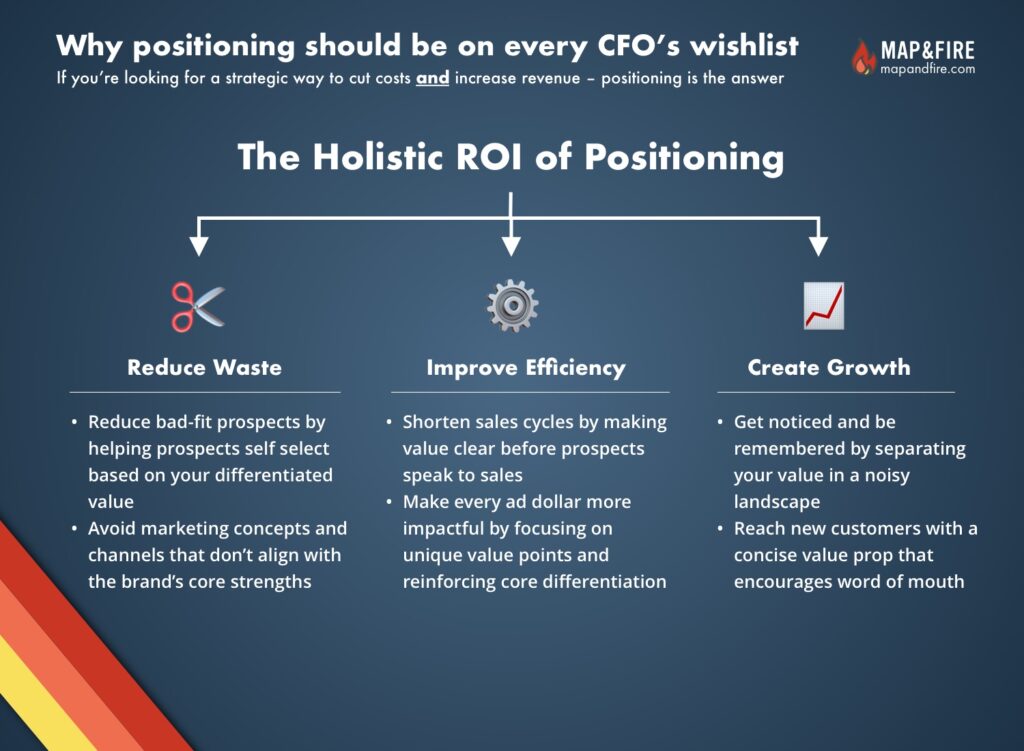
For some the idea of working on your brand and positioning strategy might sound fluffy…
…until you realize the impact it has across your bottom line.
Positioning is the heart of your business.
It defines your target customers and their needs, your unique strengths and points of differentiation in the market, and how your offering delivers value.
Which means if you’re…
Refining your sales pitch? Consult your positioning.
Developing a new ad campaign? Consult your positioning.
Scoping new product features? Consult your positioning.
Planning the next 6 months of the business? Consult your positioning.
All these activities have a direct impact on the bottom line and they all require alignment with your positioning to be impactful.
Positioning is that rare strategic activity that hits on the financial success of your business from every angle.
4. Use positioning to prioritize your value
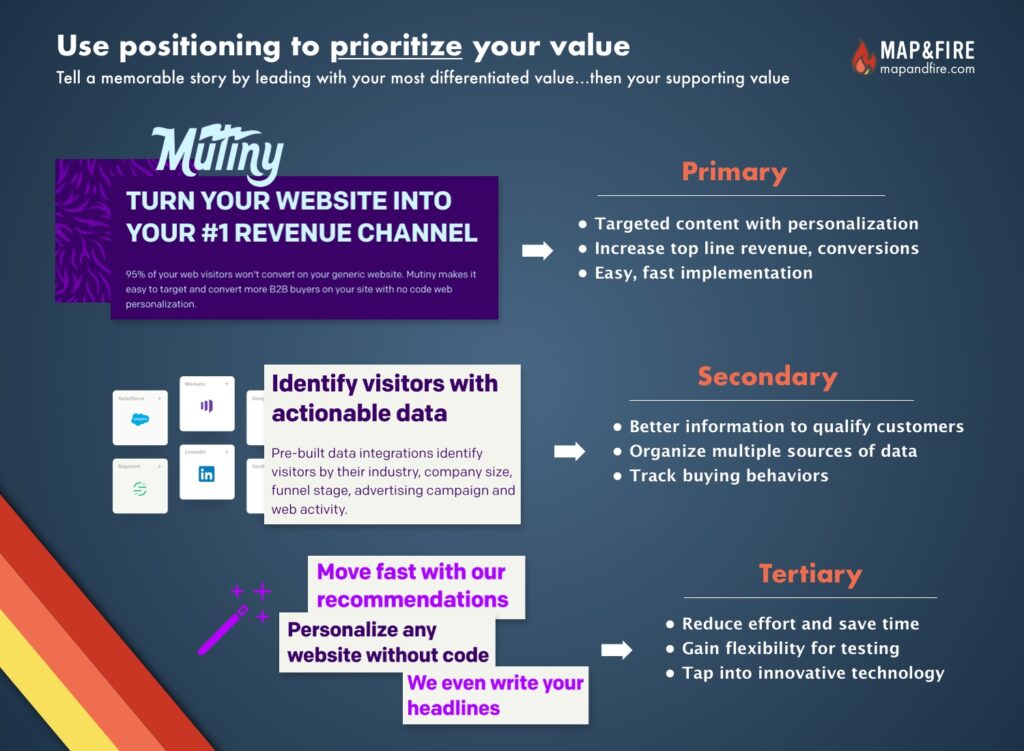
The goal of your positioning is not to be like the film: Everything Everywhere All at Once.
Instead, it’s the opposite. You want to be a specific thing, for a specific customer need, in a specific circumstance.
Your positioning strategy then becomes an exercise in prioritizing your brand’s value.
Brands deliver value across multiple tiers of customer needs.
- Functional (e.g. save time, reduce cost, simplify, etc.)
- Emotional (e.g. reduce anxiety, health and wellness, design, etc.)
- Aspirational (e.g. provide hope, affiliation, self-actualization, etc.)
And within each of those buckets you may deliver on a wide range of points.
Defining a strong position then becomes about two key steps:
- Identify all your relevant points of value
- Prioritize those points around where you provide value at the highest *and* most differentiated levels
Your top 2-3 points serve as the core of your positioning.
These are the points that give you the best opportunity to stick in your customer’s crowded brain.
These are the points that you want to drive home in all your communication.
Every touchpoint from marketing, to sales, to social all need to be reinforcing these ideas consistently.
But your story doesn’t end there.
You can still speak to the other points of value that your brand delivers on.
There are naturally going to be supporting or table stakes levels of value that you want to address to tell a complete picture of how your brand satisfies your customer’s Jobs to Be Done.
What’s critical though is that you understand the priorities of those points so that your core positioning and messaging don’t get muddy.
When you use a structured positioning process you can tease apart that value to tell a more compelling and memorable story.
5. Your positioning is relative to the competition
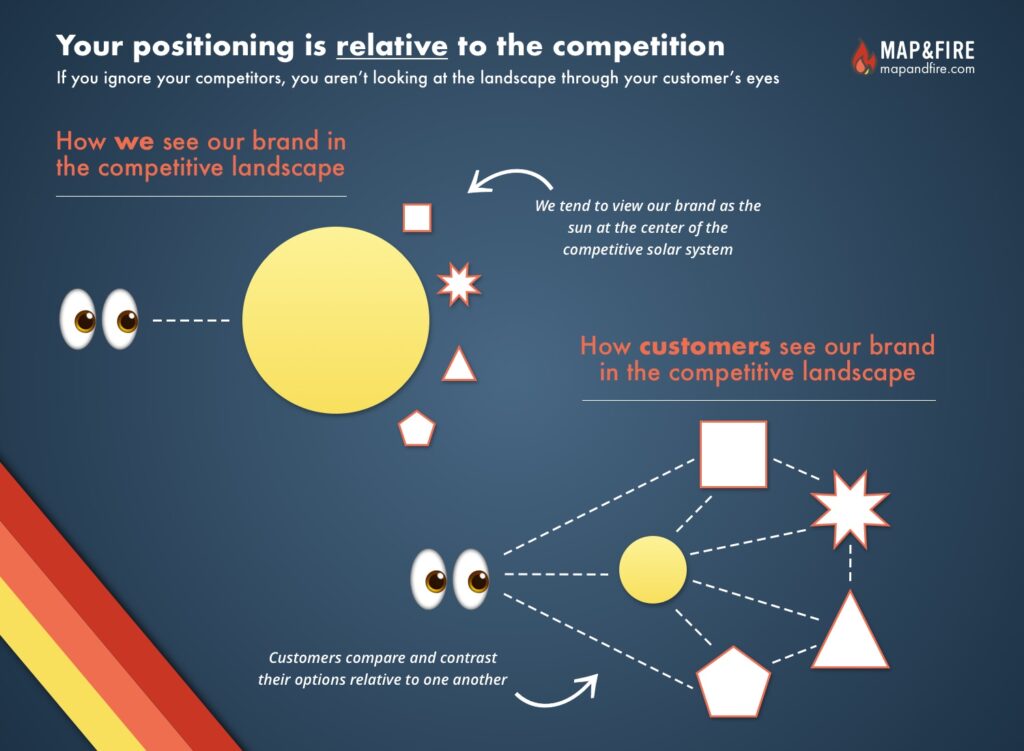
A close cousin to believing you don’t have any competition is the stance of “I don’t even look at the competition.”
The message is often accompanied by statements like:
“We need to focus on ourselves”
“We prefer to only focus on our customers”
“We can’t be unique if we clutter our minds with what others are doing”
The problem with this thinking is that it ignores how your customers view the landscape.
Your brand positioning strategy doesn’t exist in a vacuum.
Your positioning is relative to competitors within your market.
The whole premise of differentiation is that you offer a unique mix of value that diverges from other solutions your customers consider.
Without understanding the competition you can’t fully understand what that unique position is.
Rather than viewing the competition as some distraction it should be fuel to show you were to double down in order to stand out.
Focusing on your customers is critical and should be at the front of everything you do, but it’s not an either-or situation. You can and should do both.
6. Revisit your positioning…but not too often
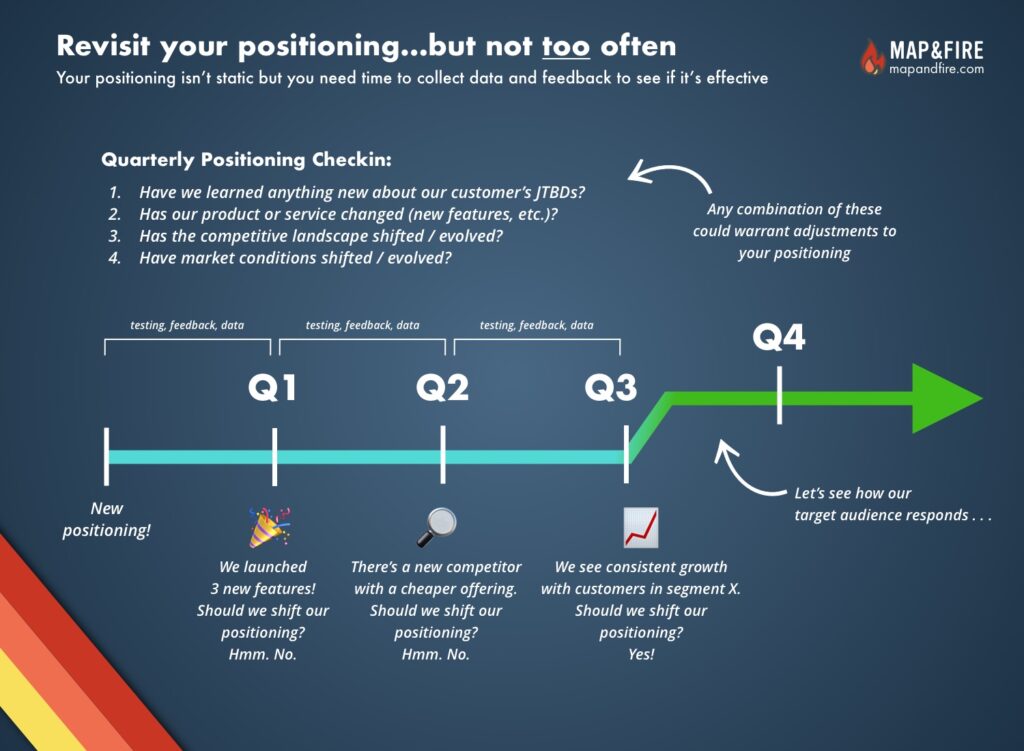
Your brand positioning strategy is not a set-it-and-forget-it kind of thing.
…but it’s also not something you should change every time the wind blows either.
In order to determine if your positioning is effective you need data and feedback.
This means you have to:
- Talk to customers via sales and interviews
- Gather marketing insights
- Research the competition
- Look at shifts in sales
Over the course of a given month there are going to be shifts and insights around any or all of those areas.
It’s easy to overreact to blips and mistake them for actual trends.
And if you switch up your positioning every time a blip pops up, you’ll never be able to gauge what’s working.
Your brand won’t have time to deliver a consistent message and your customers won’t have time to learn, digest, and remember what your unique value is.
At the same time you don’t want to go too long either.
Customers, competition, and markets are all dynamic and they can all impact your positioning.
A good middle ground approach is to do quarterly positioning reviews.
During these reviews you can ask questions like:
- Have we learned anything new about our customer’s JTBDs (Jobs to Be Done…aka. what they’re seeking to accomplish)?
- Has our product or service changed (new features, etc.)?
- Has the competitive landscape shifted / evolved?
- Have market conditions shifted / evolved?
If you answer “yes” to one or more of these you’ll next need to determine if any of those changes create significant new opportunities (or risks) for your business.
If you do see a big opportunity or need for a positioning shift, you may want to do some soft testing before you roll it out.
- Conduct some interviews
- Test out a new sales pitch
- Set up a new landing page
7. Build stronger customer relationships with higher level value
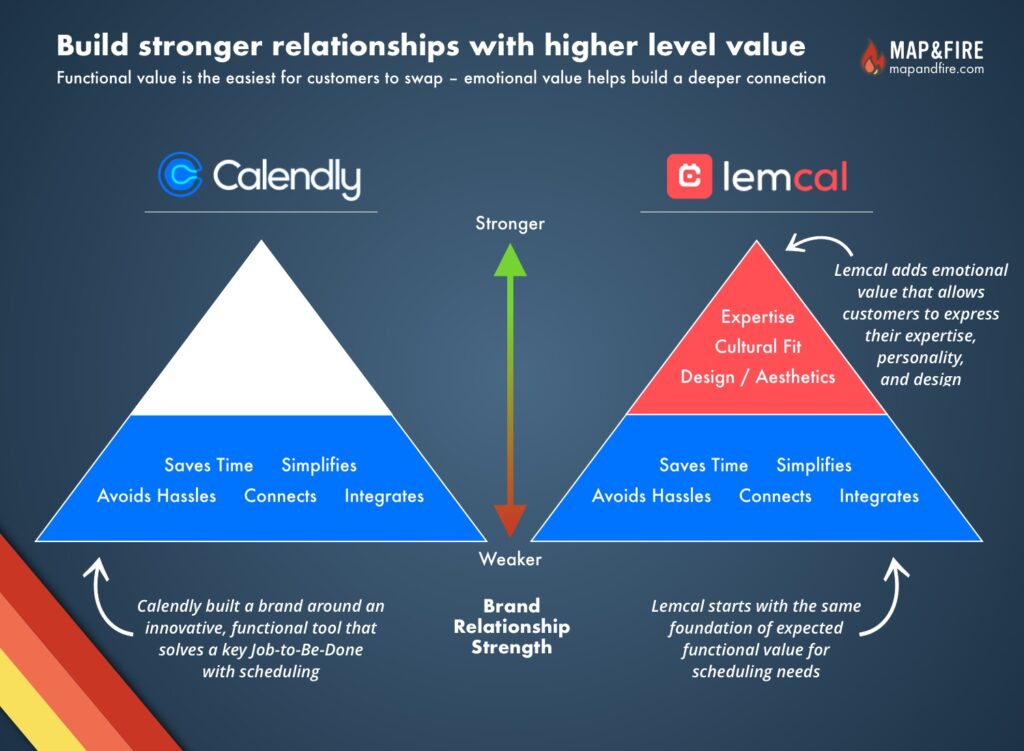
The best part about providing functional value to your customers is it solves their immediate pain points.
The worst part of functional value is it’s also the easiest to replace.
Faster, easier, cheaper. We all want solutions that meet those base level needs.
Satisfying your customer’s immediate pain points can help your brand get its foot in the door.
The problem is that functional value is also the most shallow. It’s easier for competitors to replicate and improve on.
It leads to customer relationships that are very practical – and makes your brand very switchable.
A great example of this is with airlines – if I believe:
- …they’re all going to treat me about the same
- …and they all get me to the same place
- …I might as well go with the cheapest option
That’s not the recipe for building a strong brand.
On the other hand, if you can layer in deeper levels of value that tap into your customer’s emotional and aspirational needs you can build a stronger bond.
How can you lean even more into the emotional side to build deeper customer connections?
8. Clarify your positioning, then optimize messaging
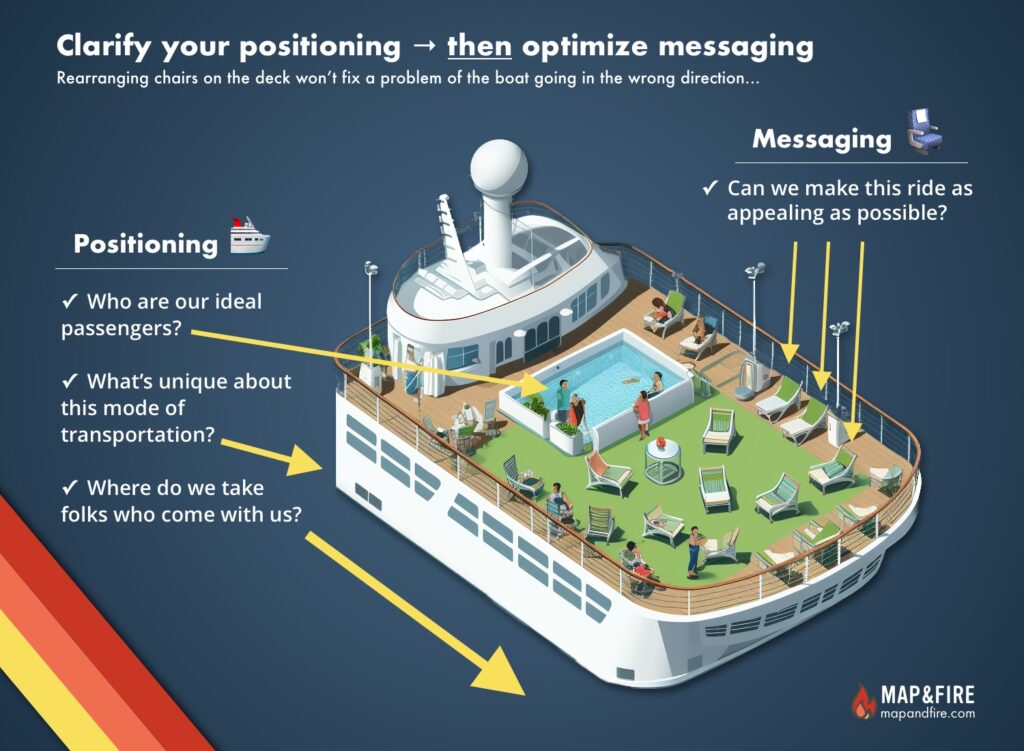
You can’t fix a problem with your positioning strategy by applying new messaging.
It’s like trying to change the course of a cruise ship by rearranging the deck chairs. You’ll have a new view but you’re going in the same basic direction.
When your brand is struggling to connect with customers it’s tempting to just write some new copy.
It’s fast, it’s easy, and you feel like you did something.
But it might be time to take a step back and look at the strategy underneath.
Are you crystal clear about:
- Who your customers are and what they need?
- What your key points of differentiation are?
- How you deliver value in a unique way?
Of course to uncover those answers you need customer research.
But once you have those insights you need to dig into your positioning. Challenge the ideas you might take for granted about your audience, the market, and your product.
Once you’ve done that, then you can work on making meaningful updates to your messaging.
And if your first attempt still isn’t quite right you’ll now have a structure to help inform new iterations.
You’ll have a clear idea of what to test, how to tweak, and why you’re doing it.
You can guide the ship instead of endlessly rearranging deck chairs.
9. Fill your positioning cracks with gold
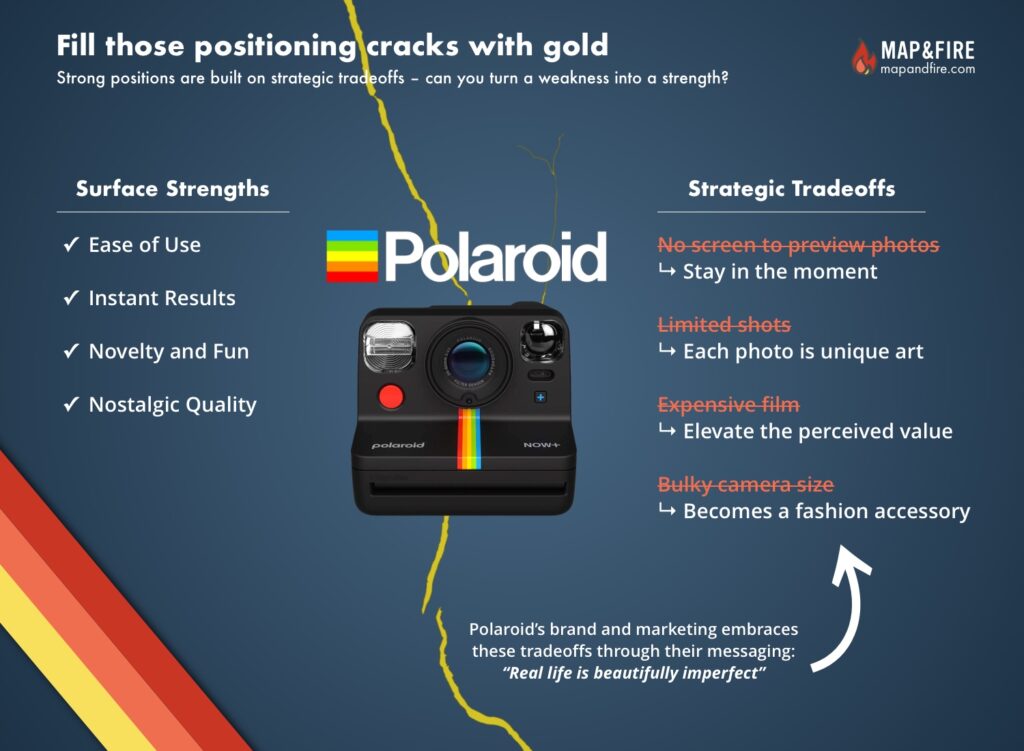
Strong brand positioning is like the Japanese art of Kintsugi pottery.
In Kintsugi, broken pottery gets repaired with a special lacquer mixed with powdered gold.
Patterns of cracks which normally would appear as glaring imperfections now become the focal point of a unique piece of art.
Your positioning strategy works in the same way.
A strong, unique position is built around making strategic tradeoffs.
Your goal is to provide:
- Differentiated value
- To a specific audience
Both of those pillars require tradeoffs:
- Your offering focuses on certain points of value (instead of others)
- You deliver it to certain types of customers (instead of others)
In one light the tradeoffs you make might appear as weaknesses (or cracks) in your position.
But it’s those strategic decisions that create focus around your position and make it distinct in the market and memorable for customers.
10. Positioning lives right in the center

Think about building your brand positioning strategy by defining 3 core areas of your business:
- Customers: Understand the motivations and desire outcomes of a specific segment of people
- Competition: Among your competitors where do you provide the highest level of value that also diverges the most from what they offer
- Offering: Align your product or service with the needs of your customers and tease apart the standard feature you provide from the highlights
Your unique position lives at the intersection of those 3 areas.
Define each area in that order and you’ll be on your way to developing a strong positioning foundation that customers will remember.
11. A little humor can go a long way (especially in B2B)

We’ll end this list with a fun one.
Your brand doesn’t have to be hilarious to get value from humor.
Particularly in B2B it’s easy to fall into the classic trap of “customers won’t trust us if they don’t think we’re serious”.
But there’s a massive spectrum in potential tone when it comes to humor.
Sure, if you push too far into irreverence it could rub some people the wrong way. But at the same time when you push deep into hard-core, ultra-dry business speak you run the risk of people tuning out and immediately forgetting you.
Two routes with the same result: no engagement.
Luckily there’s a lot of room in between.
By sprinkling in pieces of comedy in your messaging and visuals you can create an experience that accomplishes two critical goals for any brand:
- It keeps you engaged so you consume the content
- It helps you remember what you consumed
That’s all you can ask for from an initial impression of a brand.
All you have to do is push the edge a little without going over it.
If you’re trying to figure out how to set your B2B brand positioning apart remember a little humor can go a long way.
Apply one piece…or try them all
The goal of this list isn’t meant to be an exact step-by-step recipe for how to improve your brand positioning strategy. Instead, think of it as a set of ideas you can explore over time.
Even if you only work on one piece of your positioning puzzle it can make your strategy a little bit stronger.
Positioning is complicated and it’s always evolving. Just when you think you’ve locked in the final piece, something will shift to create new openings in the puzzle.
Hopefully these visuals provide some new ways to look at your brand positioning strategy to help spark ideas to explore. It’s a complex topic but taking the time to build that strong foundation improves everything else you do as a brand.

Get Help Crafting Your Brand Positioning Strategy
If you’re ready to build stronger connections with your customers, reach out for a free consultation. We’ll help you transform your best business thinking into an actionable, shareable, growth-oriented guide. Click below to learn more about the Brand Guidebook process.

